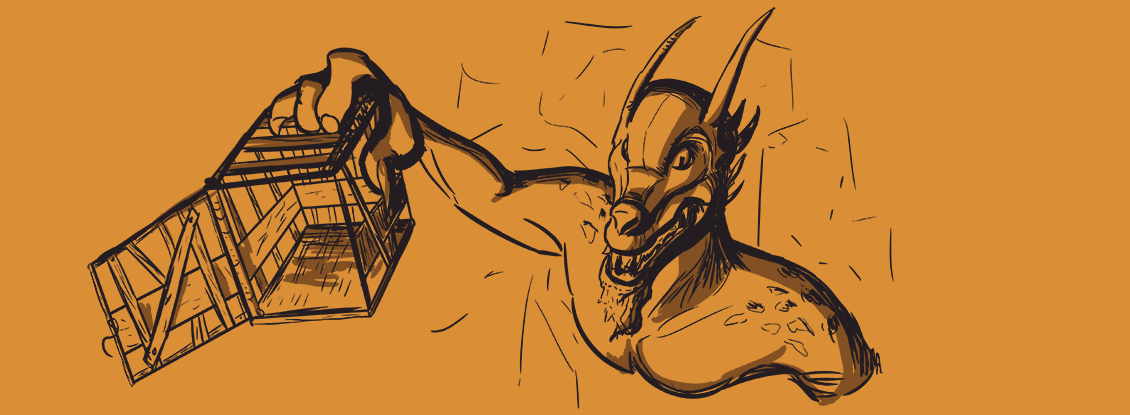Ambivalent sprites of hearth, mines, and sea.
Kobold Lore
 Illustration by @danaxbraga
Illustration by @danaxbraga
“Salamander shall kindle, Writhe nymph of the wave, In air sylph shall dwindle, And Kobold shall slave.”
The man nearly dropped his lantern as he stumbled over a sudden rise in the rock. It scared him a bit. By now he was deep enough into the mine shaft to start forgetting the direction he had come from. He had scrawled directions back for himself on a piece of parchment which he had shoved into his right pocket. In this part of the mine the air was stagnant, and he had to rely entirely on the lantern for light. He silently cursed Pestle. The local apothecary had sent him on an errand to gather wax, which was the reason he had entered the damned mine in the first place. There were stories about tiny creatures who lived in the mines and collected candles. He figured he would be in and out in less than an hour, and that he could handle these stupid creatures without any trouble. It sounded like easy silver. What kind of dumb animal would steal people's candles? With his mind dwelling on the coin purse he would get, he didn't notice the rope on the ground. Suddenly, he felt a tight squeeze around his ankles. He reeled forwards, trying pointlessly to catch his balance. He smashed into the ground, dropping the lantern and plunging himself into darkness. He cursed and, at the same moment, he heard a clattering sound coming from deeper in the mine that sounded like pots and pans falling down a staircase. Some sort of bell? He felt around his feet and found that they were fastened tightly together by a noose. The rope was thick and the knot seemed expertly crafted. He started to pull free his short sword with one hand, while the other absently groped for his missing lantern. Pestle was going to pay for this annoyance! Next time he could fetch his own damn candles. Candles… He could see the rope now. He slowly realized the mine shaft was lighting up. He turned around and saw it, an unmistakable glow growing fast. He could make out shadows dancing across the rough-hewn stone. He heard the sounds of dozens of distant scrapes and knocks echoing towards him. He started sawing at the rope around his feet, but the secret part of his mind, the terrified part, knew he was too late. The Kobolds were coming and they would find him just the way they wanted him – trapped and helpless.
Kobolds are ancient and their origins are obscure. In the distant past, they were creatures of the spirit realm and would only occasionally visit the physical plane. As they spent more time among humans and other creatures of the physical realm, their interest and commitment gradually increased. Over time, this lead to well established physical traits and lineages of kobolds that maintain a more permanent presence. Nowadays, you rarely hear of an incorporeal kobold causing mischief or vanishing into thin air. Those may still exist, but we only hear of the common humanoid types: kobolds bound to households, kobolds of the mines, dragonoid kobolds, and kobolds bound to ships.
All the lineages of kobolds share some common features. They are shaped like humanoids that stand about as tall as a four year old human child. The size can vary slightly depending on the breed. Kobolds of the mountain, home, and sea appear as a strange mix between grown man and child. Short and thick-set, they combine features of the young and old, such as a beard, with soft child-like hands – or they might have the wide eyes of a child set in a shriveled old face. They wear human clothes and particularly enjoy hats. The kobolds at sea dress like the sailors do. Dragonoid kobolds are physically different but have a similar height. They have lizard-like tails, clawed hands and feet, and long snouts. Their skin is covered in scales. This difference is explained by their unique heritage. All kobolds can be benevolent or adversarial. Even when you manage to have a kobold working for you, they are quick to anger. They say even the friendliest kobolds are rarely completely good and the slightest offense will set them off. They have a penchant for mischief that can sometimes get completely out of hand. The tale of Hödekin, who worked for the Bishop of Hildesheim illustrates this point. In fact, for the household kobold, there are many tales of humans trying one thing or another to expell them:
Kobolds of the mines
The details of household kobolds, their binding rituals, and their roles in history are many and varied. We might elaborate in the future, but for now we must turn to the kobolds of the mountain. These types of kobolds have shunned more direct human contact in favour of their own tribal affiliations and the treasures of the mountains. They are reknowned for their skills in tunneling and in trap making. These types of kobolds are often accused of cave-ins and luring miners with false promises. Miners would encounter veins of rich gold and ore, but when smelted, the ores would reveal themselves to be a poisonous, burning gas. This particular trap became well known by humans so they named those ores cobalt after the creatures they knew were to blame. In 1735, Swedish chemist Georg Brandt isolated a substance from such ores and named it cobalt rex. In 1780, scientists showed that this was in fact a new element, which they named cobalt.
Kobolds of the sea
Kobolds of the sea (sometimes called Klabautermann) enter a ship via the wood used to build it. They are then bound to the ship, appearing as the ship's carpenter. Should you ever glimpse a short crew member in yellow, wearing a woolen sailor's cap, smoking a pipe, and clutching a cauking hammer, you will know you have glimpsed a sea kobold. Sometimes their likeness is carved on a mast as a symbol of good luck. Their watercraft is unparalleled, and they are generally known to help the ship. But, like all kobolds, they are prone to mischief and quick to anger. Even darker legends of these kobolds claim that they only appear to the crew of a doomed ship.
Dragonoid kobolds
The dragonoid kobolds are well known by seasoned adventurers. They are more commonly vile but, like the mining kobolds, stick to themselves unless strongly coerced to do otherwise. The obvious question is why they appear so differently than the other lineages of kobold. The ancient histories hold a clue. As mentioned before, the earliest kobolds maintained a more transient form as spirits, and a common form was a fire spirit. Those fiery kobolds were named "drakes". Benjamin Thorpe describes them as "a fiery stripe with a broad head, which he usually shakes from one side to the other…". The connection to fire is also made clear by legends of kobolds who would take the form of candles. Seasoned adventurers may have heard an angry mining kobold scream at the top of its lungs "you no take candle!!". It is entirely possible that the kobold believes those adventurers are carrying away its own kin, or at least an effigy that represents them. It is my contention that, in the old times in the mountains of germany, a great dragon (probably a descendant of the cursed dragon Fafnir) encountered one of these fiery kobolds in it's flying form and mated with it. The confused drake found shelter in a cave and, against the odds, laid several eggs. These then became the progenitors of the dragonoid race of kobolds we know today.
Written by Giles Ravensong.
